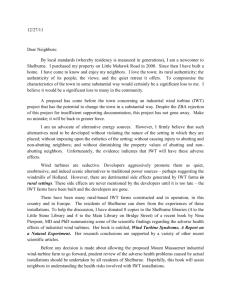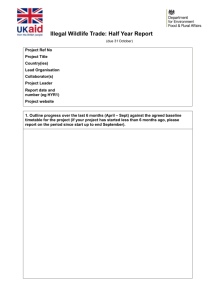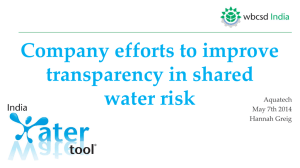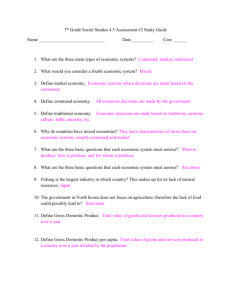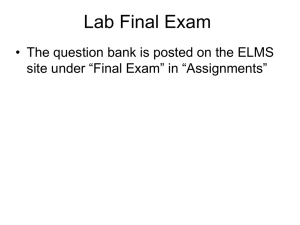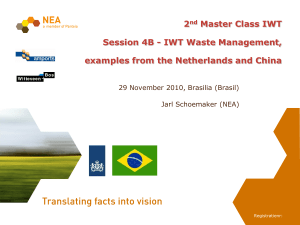Report of discussions on IWT at the first Asia Pacific Water
advertisement
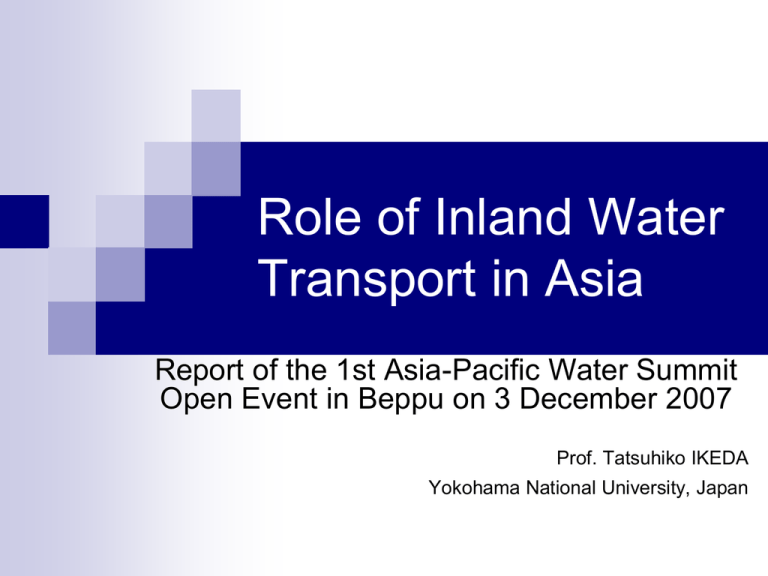
Role of Inland Water Transport in Asia Report of the 1st Asia-Pacific Water Summit Open Event in Beppu on 3 December 2007 Prof. Tatsuhiko IKEDA Yokohama National University, Japan Background for the use of Inland Water Transport (IWT) • IWT is a mode with low cost, energy efficient, and environment-friendly. • At the Water and Regional Development Sessions of the 3rd and 4th World Water Forum held in Kyoto (2003) and Mexico City (2006), it was recommended that IWT be further promoted and utilized to realize regional development. Unit emissions of carbon dioxide by transport mode (Unit: Ratio of CO2 emitted to transport 1 ton of cargo 1km) Coastal Shipping 37 Rail 22 Commercial Trucks 161 Private Trucks 971 Air 1,500 0 200 400 600 800 1,000 1,200 1,400 1,600 Source: Based on the Report on the Japan Greenhouse Effect Gas Inventory (October 2004) and Overall Energy Statistics (FY2003) 1 The 1st Asia-Pacific Water Summit Open Event • Symposium on ‘Waterborne Transportation and Regional Development’ was held in Beppu on 3 December 2007 as an Open Event of Asia-Pacific Water Summit. • Senior administrative officials concerned and researchers in Japan, China, Korea, Vietnam and Cambodia made presentation on the use of IWT in their country. • Various issues and challenges were discussed for further promoting IWT in the region. ■Theme: Waterborne Transportation and Regional Development ■Panelists (Alphabetical Order) Mr. Mikio ISIWATARI Mr. Kazuo ITOU Dr. LEE Sung-Woo Dr. Katry PHUNG Dr. TRAN Dac Suu Mr. Yifei ZHAO Senior Adviser, Japan International Cooperation Agency (JICA) Chief Executive, Seaport and Airport Bureau, City of Kitakyushu Research Fellow, Port Research Department, Korea Maritime Institute (KMI) Director, Waterways Department, Ministry of Public Works and Transport (MPWT), Cambodia Director-General, Vietnam Inland Waterways Administration (VIWA) Associate Professor, Shanghai Jiao Tong University, China ■Coordinator Prof. Tatsuhiko IKEDA, Yokohama National University, Japan Photo: OITA GODOSHIMBUN, All Japan Regional Newspaper Federation 2 Dr. Phung Katry Director, Waterways Department, Ministry of Public Works and Transport (MPWT), Cambodia “Support People's Lives” About 3.9 million people (one-third of the national population) live beside the Mekong River in Cambodia. They depend on IWT. The Mekong River 3 Vessel seize restriction on Mekong River Domestic cargo/passenger route -International route : Ocean going vessels with 5,000 DWT can access with the depth of waterway of 5 meters International Cargo/Passenger route -Domestic navigation route: vessels with 500 DWT in wet season and 70 DWT in dry season (the depth of waterway is 2 -2.5 m in dry 4 season. Inter-provincial Cargo movement by Waterway Domestic Cargo transported from PP Port to Provincial Towns Thousands ton 15 10.896 11.007 9.087 10 5.399 5 2.633 0 2002 2003 2004 2005 2006 year The volume of waterway long distant transport between Phnom Penh Port and Provincial towns has decreased since 2003 due to the improvement of road network and insufficient loading facilities in each port. However, internal cargo transport within province still remain as an important transport mode in the region. 5 Waterways transport and international trade 235 Thousands ton 250 45 216 38 200 35 30 30 150 25 99 100 50 77 57 73 15 10 33 5 27 0.746 2002 20 16 8 35 12 0 40 0 2003 2004 2005 2006 Thousands TEU Cargo Movement in Phnom Penh Port The volume of container cargo handled in Phnom Penh Port has been increasing since 2002, when a container line service between Phnom Penh Port and Ho Chi Minh City was put 6 in operation. Dr. TRAN Dac Suu Director-General, Vietnam Inland Waterways Administration (VIWA) “Support People's Lives” IWT is utilized fully for both passenger and cargo transportation in Vietnam. The superannuation of the port facilities becomes a problem because the investment in the improvement of the port facilities is not enough. The system of the South The system of the North 7 VIETNAM INLAND WATERWAY ADMINISTRATION Vessel management In the period of 1993 - 2005 the number of river vessels increased dramatically. Vessel 90000 75588 76624 69076 80000 65258 70000 56188 60000 43087 50000 32929 40000 30538 30000 20000 10000 0 1995 1996 1997 1998 1999 2000 2001 2002 86207 82046 78108 2003 2004 2005 Year 8 IW Transport capacity inland waterway cargo transport capacity from 1995 t0 2006 Mil Ton 65 70 60 55 60 50.97 50 40.7 42 40 30 25.81 27.97 30.6 33.8 44.8 37.5 20 10 0 Year 1995 1996 1997 1998 1999 2000 2001 2002 20032004 2005 2006 Inland waterway transport capacity is very high and has increased rapidly consistetly. 9 Dr. LEE Sung-Woo Research Fellow, Port Research Department, Korea Maritime Institute (KMI) “Support The Development of The Region” Short shipping routes between Japan, Korea and China are fully utilized for their trade. They are important to stimulate the economy of the hinterland of their ports. Korea China Japan 10 Present Situation of Korea/China/Japan Short Shipping Routes ◈ Deepening Intra-trade in Northeast Asia Unit: Thousand TEU Unit: 10million Korea 67 351 China 91 619 Korea 312 469 220(1995) 805(2005) 171 240 Japan 285 841 317 2,103 China 252 1,648 156 1,018 207(1995) 778(2004) 216 986 Japan 526 1,827 Source: Korea International Trade Association, 2006 11 Mr. Yifei ZHAO Associate Professor, Shanghai Jiao Tong University, China “Support the Development of the Region” The Chang Jiang River is 5,800km in its length. IWT along the river has been extensively developed and utilized. The Government endeavors maintenance works of the waterways and the vessel standardization in the Chang Jiang River to facilitate economic development of the areas along its river system. It is necessary to enlarge the ship size and the port facilities to economically use IWT for the future of the region. The Chang Jiang River 12 The region covered by the Chang Jiang River 13 Freight Volume & Throughput of Chang Jiang River from 2001 to 2006 million tons 44.0% 500 Volume of freight 43.0% 400 42.0% 41.0% 300 40.0% 200 39.0% 38.0% 100 37.0% 36.0% 0 2001 2002 2003 Volume of Chang Jiang River Freight 2004 2005 2006 Rate in River Freight billion tons km 57.0% 200 56.0% 160 55.0% 120 54.0% 80 53.0% 52.0% 40 throughput 51.0% 50.0% 0 2001 2002 2003 2004 Turnover of Chang Jiang River Freight 2005 2006 Rate in River Freight 14 Scale of China River Freight in 2006 Hei Longjiang River 1.2% Other Rivers 25.2% Zhu Jiang River 15.5% Chang Jiang River 39.6% Jing-Hang Canal 18.5% 15 Mr. Mikio ISIWATARI Senior Adviser, Japan International Cooperation Agency (JICA) Connect People and the Region IWT is utilized for tourism and for transport of emergency materials in case of disasters. Source :Cabinet Office, Government of Japan River Bureau, MLIT Route of emergency relief goods transportation Tokyo Earthquake Estimation of Damages Number of destruction of building : 850,000 Death toll: 11,000 Emergency Relief delivered by IWT Source : Kobe Port Promotion Association 16 3. IWT for Disaster Management Great Hanshin-Awaji Earthquake , 1995.1 Land Transportation damaged by Earthquake Source : Hanshin Expressway Management Technology Center 2. Today’s IWT in Japan Traditional Culture “Benkou Ikada Nagashi” in Horikawa Canal (in Nichinan City, Miyazaki Prefecture) Source: MLIT “Ukai” (Cormorant Fishing) in Mikuma River (in Hita City, Oita Prefecture) “Yakatabune” (Houseboat) in Mikuma River (in Hita City, Oita Prefecture) Source : Hita city 18 Use form of river navigation in main river (Research in 2008) 120 100 80 60 40 20 0 Distribution Water Bus Excursion Ship Leisure Boat Other Distribution Water Bus Excursion Ship Leisure Boat Other 19 Source : Ministry of Land, Infrastructure and Transport Japan (MLIT) Mr. Kazuo ITOU Chief Executive, Seaport and Airport Bureau, City of Kitakyushu “Contribution to Recycling-Based Society” IWT as well as coastal shipping are utilized to transport waste materials and recycled materials among industrialized areas in Japan. This is a new concept of utilizing IWT and coastal shipping. Waste which is generated in the region flows in the region. Waste is recycled in the large area, entire Japan. LESS WASTE! Waste Recycle Waste Waste Production Consumption 20 Overcoming Environmental Problems Severe industrial pollution in the 1960s Smoke filled skies Polluted Dokai Bay 【1960】 【1960】 Government, industry, academia, and the people cooperate to overcome pollution problems Blue skies have returned 【Now】 Beauty returned to Dokai Bay 【Now】 21 21 Coastal Shipping of JAPAN Coastal shipping is used to facilitate the environment-friendly distribution system in Japan. Coastl Ferry Routes in JAPAN 22 Conclusion The participants of this symposium recognize as follows. • Thanks to the blessing function of water, IWT have been promoting regional development with relatively less energy consumption and with environmentally friendly manner. Further and safer operations of IWT should be sought out. • In developing IWT systems, specific safeguards are required, such as standardization of vessels, maintenance dredging and provision of navigation aids, in order to utilize existing infrastructure. • IWT has comparative advantages to transport waste materials for processing and recycling, tourists and emergency materials during disaster. • Experiences of each regional IWT should be shared to each other to improve IWT operations in each region. Further collaboration in Asia and Pacific Region should be sought. 23

